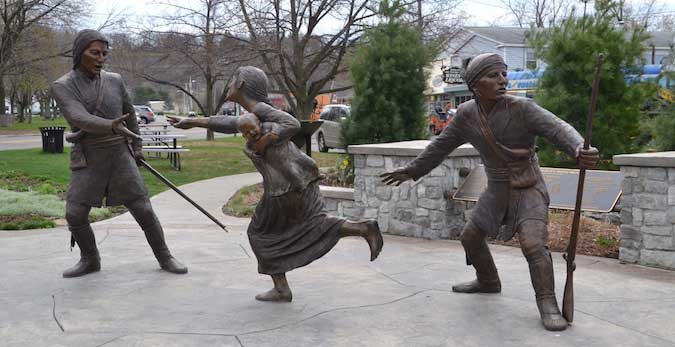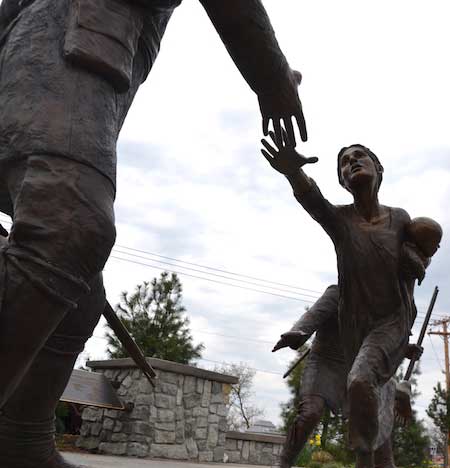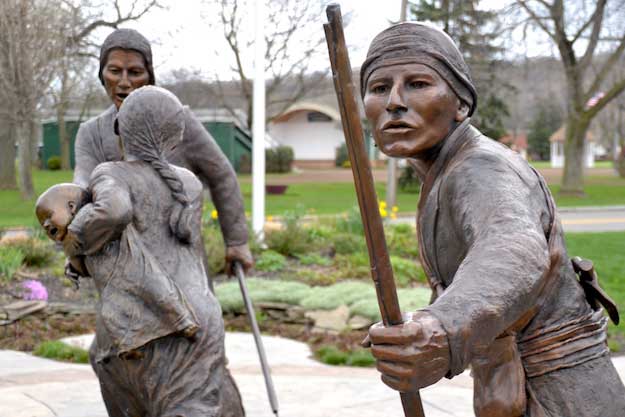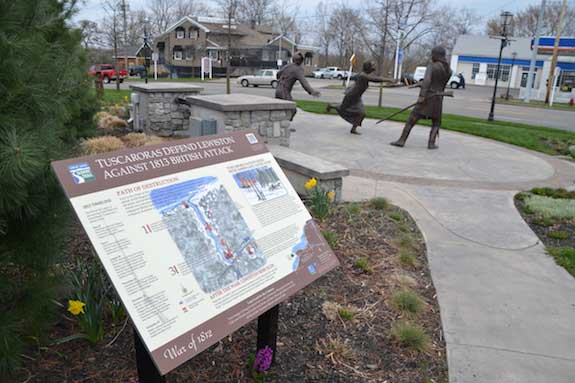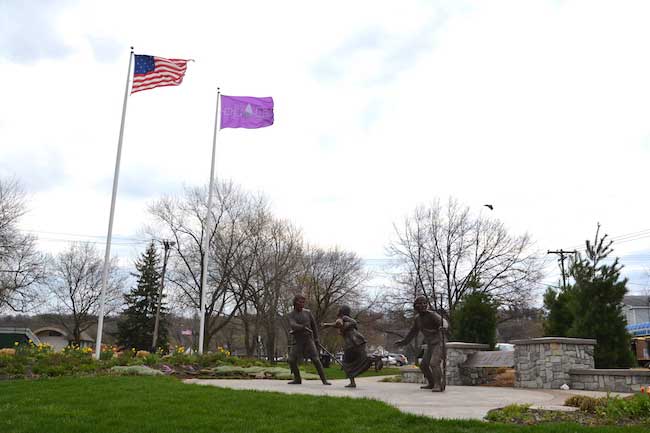Statuesque, NY: Monument in Lewiston thanks Tuscaroras for saving Americans in 1813
Photos by Tom Rivers
LEWISTON – The Tuscarora Heroes Monument was dedicated on Dec. 19, 2013, on the 200th anniversary of when the Tuscaroras, despite being badly outnumbered by British and Canadian soldiers, came to the aid of American civilians in Lewiston.
It’s hard to imagine today, but the United States faced a grave threat from the Canadian border more than 200 years ago. British and Canadian soldiers were there and the War of 1812 was being fought. (It lasted until 1815, with no changes in the border.)
The Americans burned Niagara on the Lake (then called Newark) before the Dec. 19 attack in 1813.
The angry British and Canadians crossed the border early on Dec. 19 and quick took over Fort Niagara. They then charged down River Road to the frontier town of Lewiston, seeking retribution for the burning down of Newark. The group was reportedly armed with torches, guns and tomahawks. They came upon a poorly defended Lewiston, and killed some of the civilians including small children.
The massacre would have been worse but the Tuscarora Indians came to the rescue, running down a hill from their village atop the Escarpment. Despite being outnumbered 30 to 1, the Tuscaroras offered the first defense against the enemy, and the Tuscaroras “diversionary tactics” made it appear they were in great numbers. The British and Canadians left Lewiston.
Two hundred years later, the Lewiston community said thank you with a $350,000 monument that includes three bronze statues, interpretive panels, bronze plaques, flagpoles, lighting and security cameras. (Private donations and Niagara River Greenway funds covered the cost of the project.) The monument is located at the southwest corner of Portage and Center streets.
The monument was dedicated as part of the 200th anniversary observance of the War of 1812. The Tuscarora monument was the largest display as part of the bicentennial observance. It is also believed to be the only monument from a community expressing gratitude to Native Americans.
The monuments show two Tuscarora men rescuing a local woman and her baby from the attack.
The Tuscarora intervention had been relatively unknown until it was highlighted in 2010 book, “Tuscarora Heroes,” by Lee Simonson. He led the committee to have the monument created for the Tuscaroras.
The bronze statues were created by artist Susan Geissler of Yougstown, who in 2009 earned acclaim for her statues of the “Freedom Crossing Monument” at the Niagara River. (Click here for more on Geissler’s work.)
A bronze plaque lists the names of the Tuscarora Heroes, along with the names of those killed in the attack.
The platform for the sculpture is on concrete in the shape of a turtle’s back, which reflects the Iroquois’ belief that the world was created on a turtle’s back. The turtle’s head points toward the American flag representing the American-Tuscaroran alliance since the American Revolution.
Six northern white pine trees represent the six nations of the Iroquois Confederacy. The Iroquois flag also flies at the site.
The Tuscaroras were one of a handful of Native American nations that supported the United States in both the American Revolution and the War of 1812.
Here is the inscription on a bronze plaque:
Tuscarora Heroes Monument
“In honor of the brave members of the Tuscarora Nation who defended and saved local residents during the War of 1812:
On the morning of December 19, 1813, Lewiston was attacked by British forces and their native allies from Canada. The British had captured Fort Niagara hours earlier and were intent on destroying Lewiston, in retribution for the burning down of Niagara on the Lake (then called Newark) days earlier by the Americans.
Poorly defended, Lewiston residents could only run for their lives in hopes of escaping the atrocities. Civilians were killed in the rampage and tormented parents found themselves helpless in trying to save their children.
At the moment when Lewiston citizens had lost hope, a small group of Tuscarora men ran down from their village atop the escarpment and offered the first resistance the enemy had seen. Their ingenious tactics gave the impression that “their numbers were legion.” Fearing a trap, the enemy stopped in its tracks, allowing time for the citizens to escape.
Despite being outnumbered 30-to-1, the Tuscarora Heroes risked their lives, took their courageous stand, and came to the aid of their Lewiston neighbors, saving the lives of dozens of grateful citizens.”


























